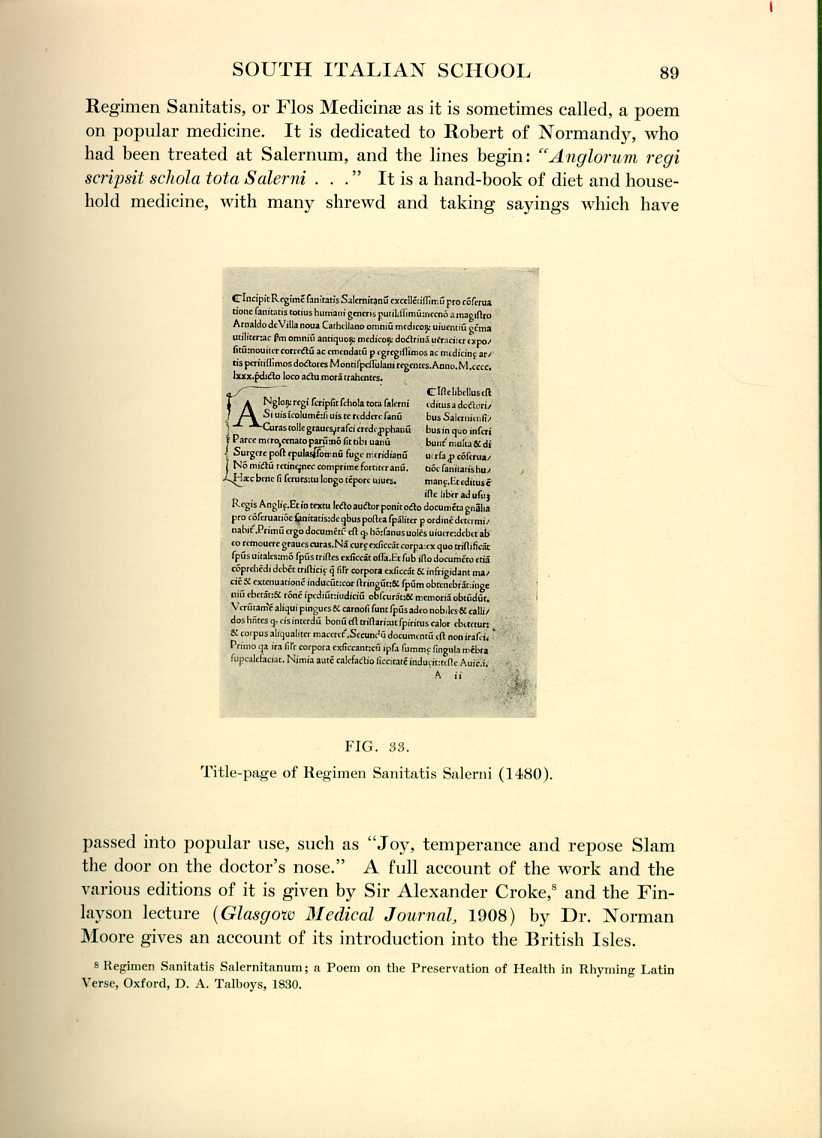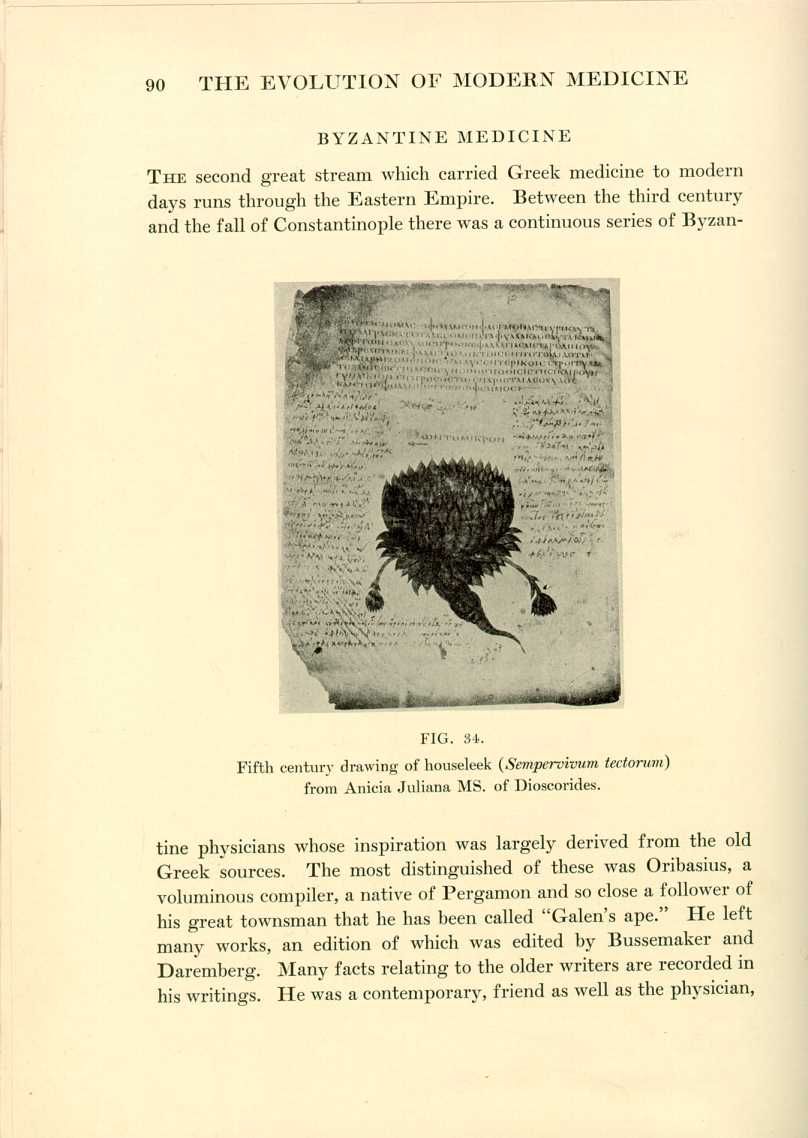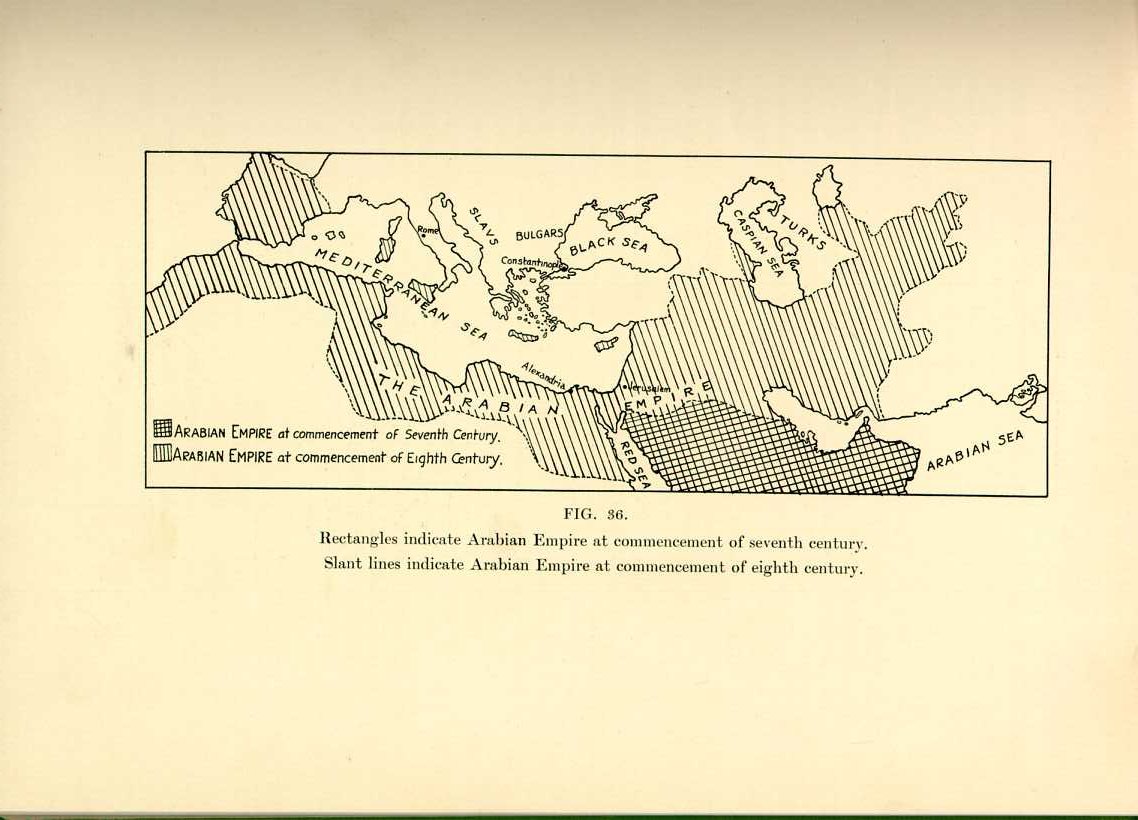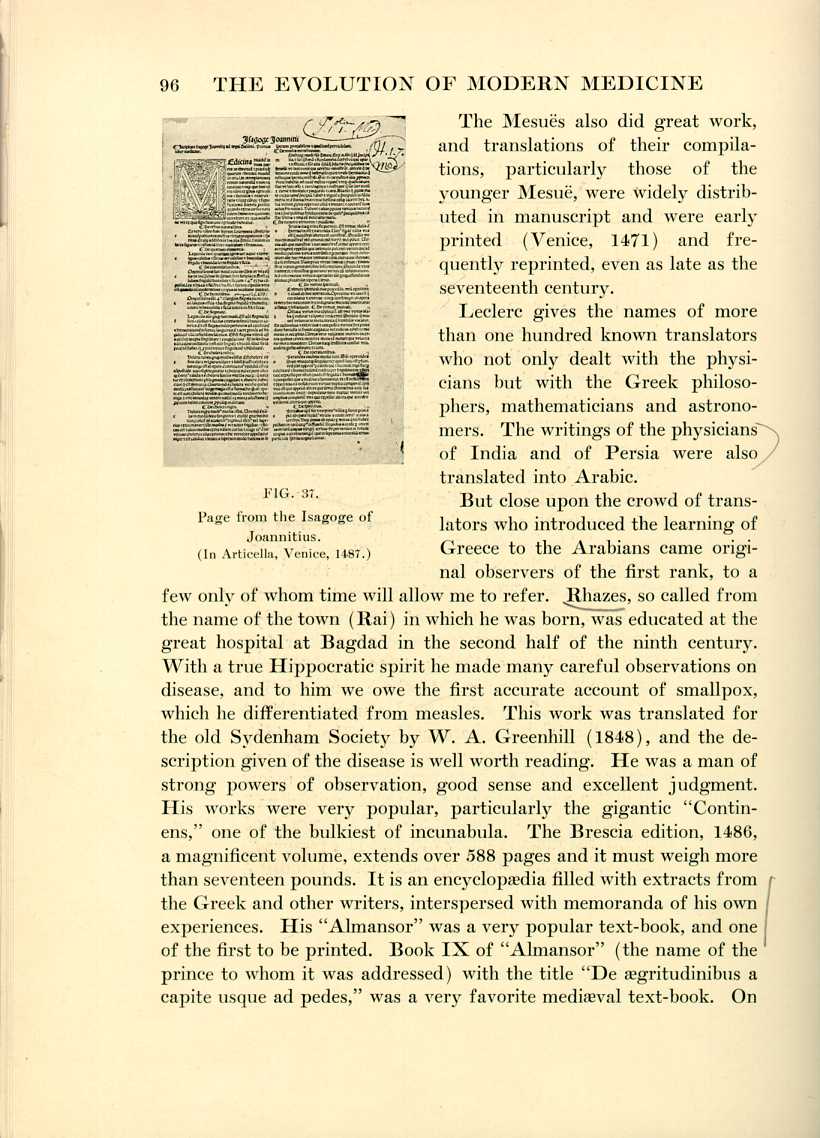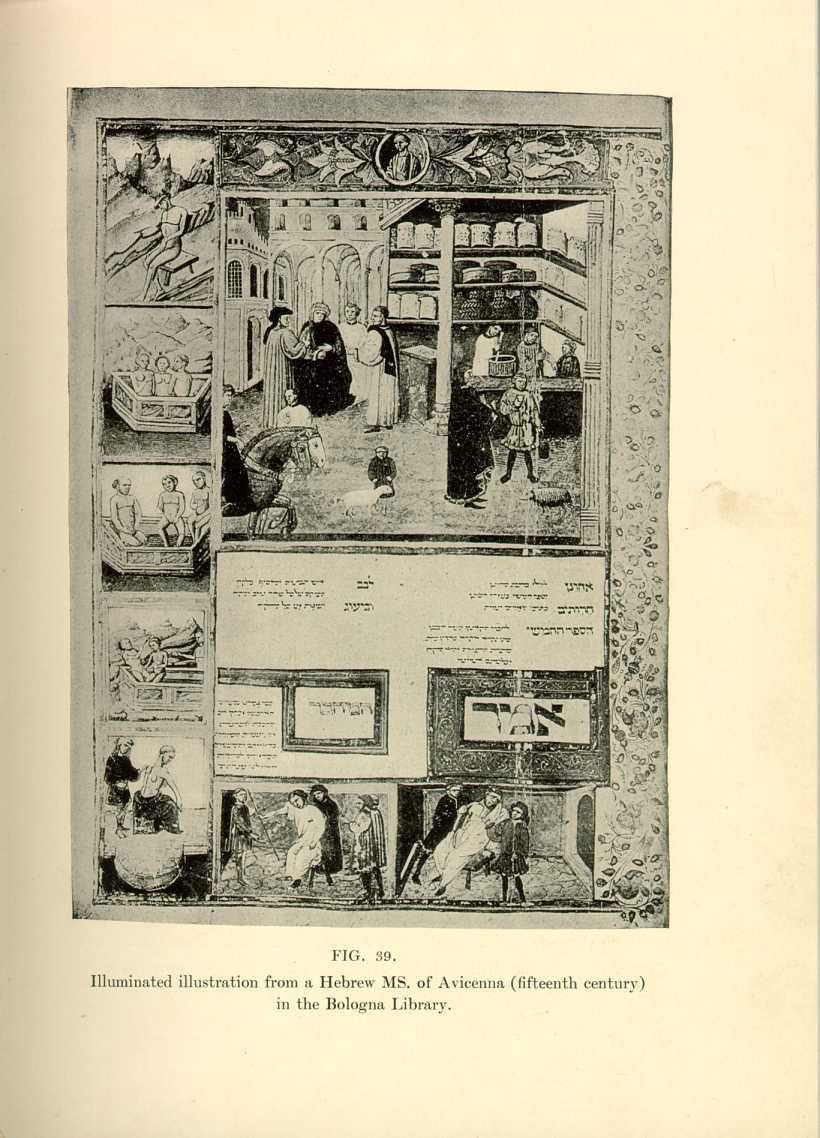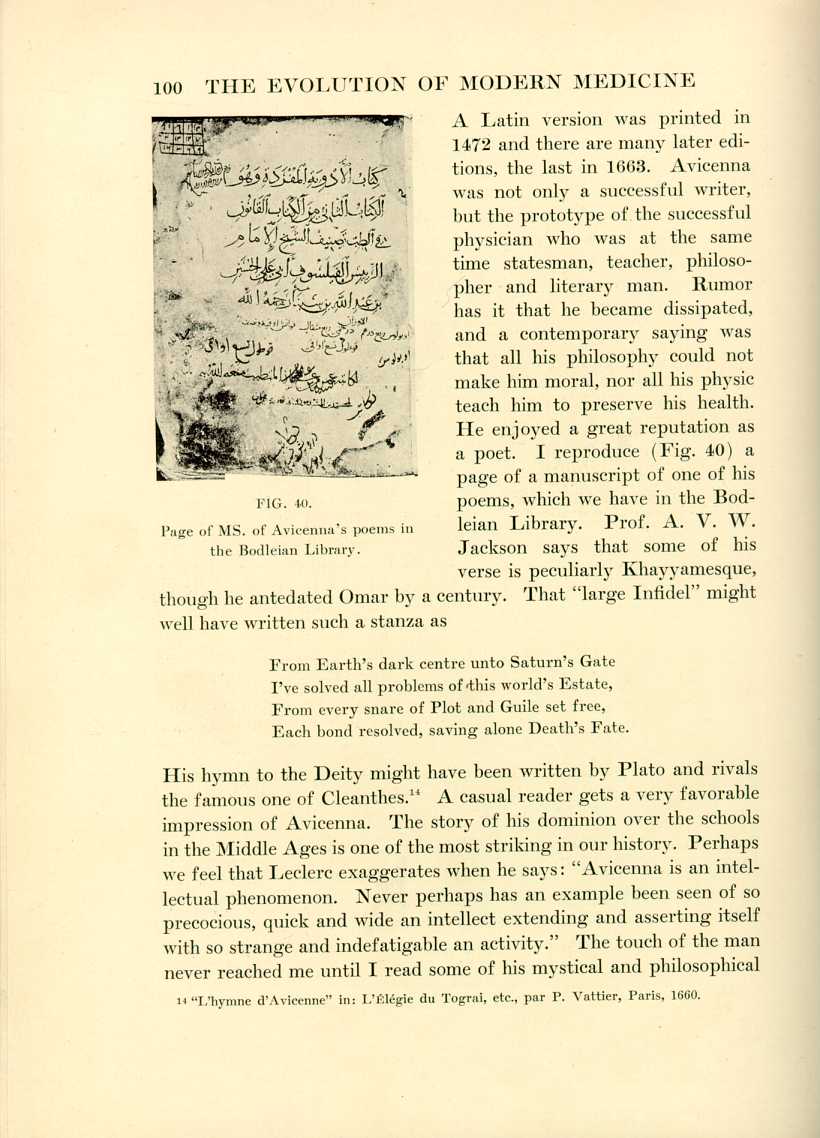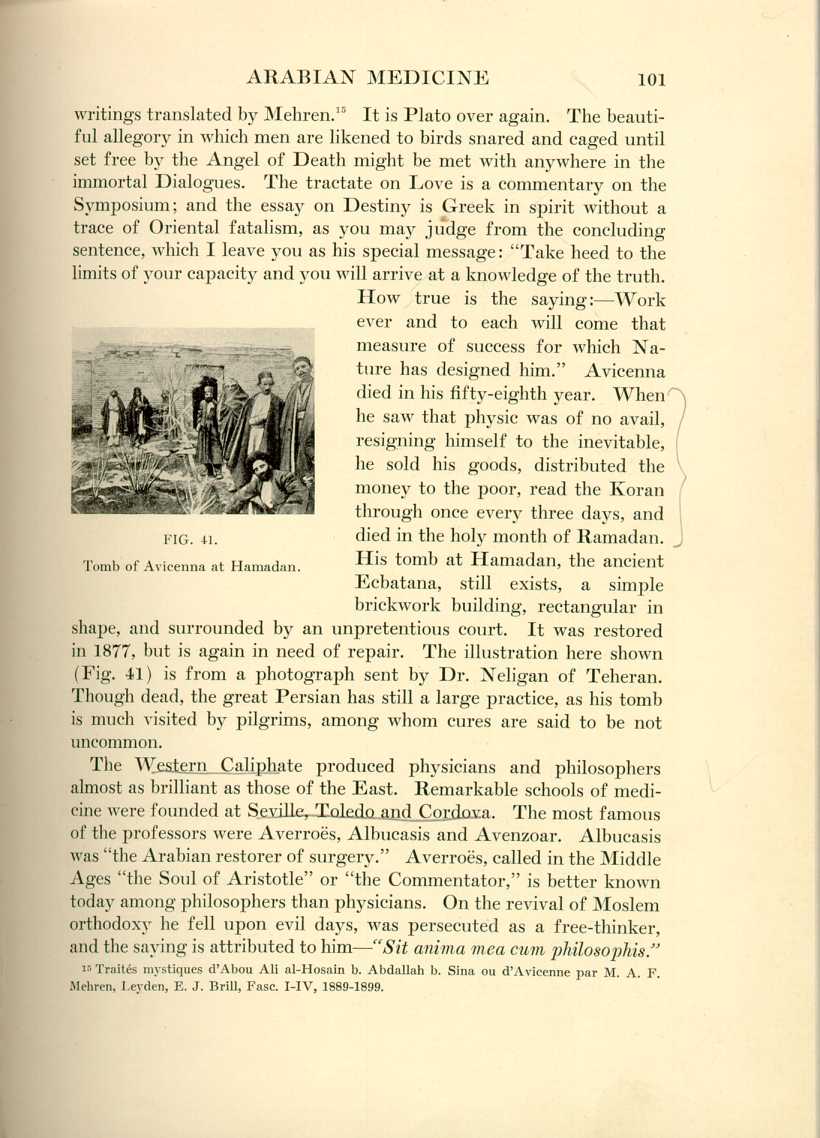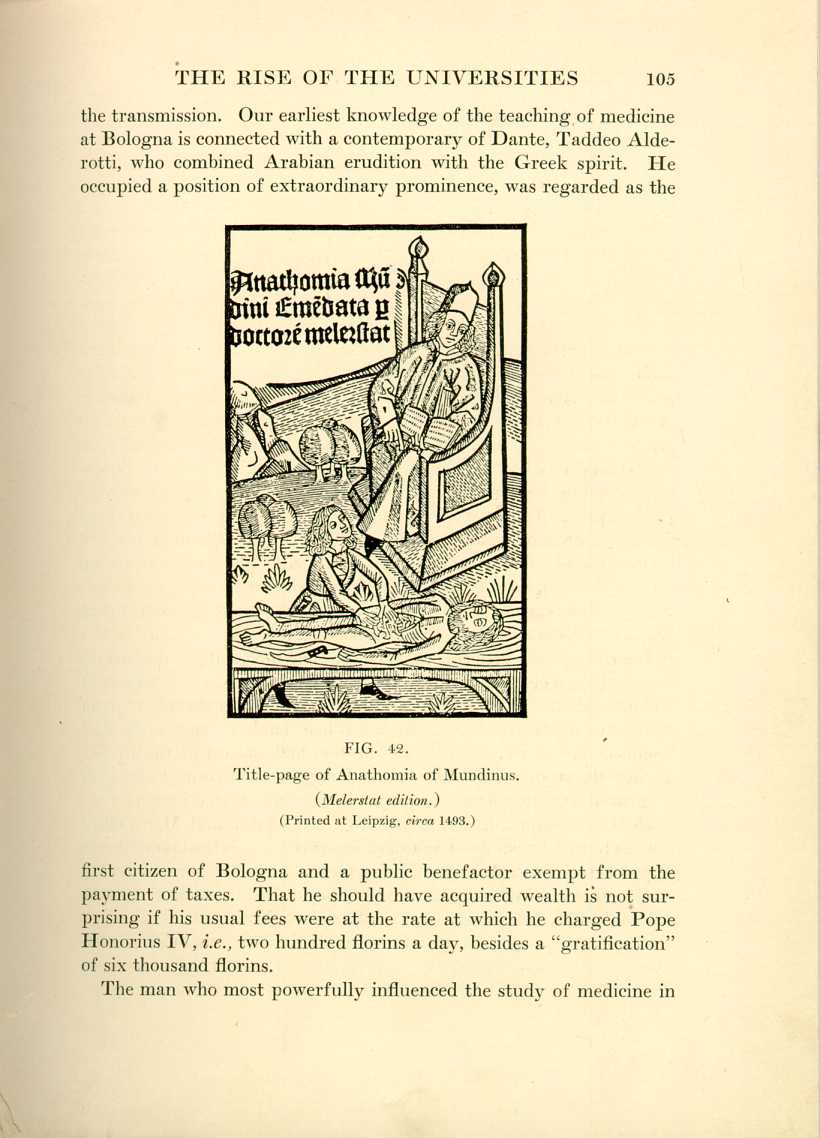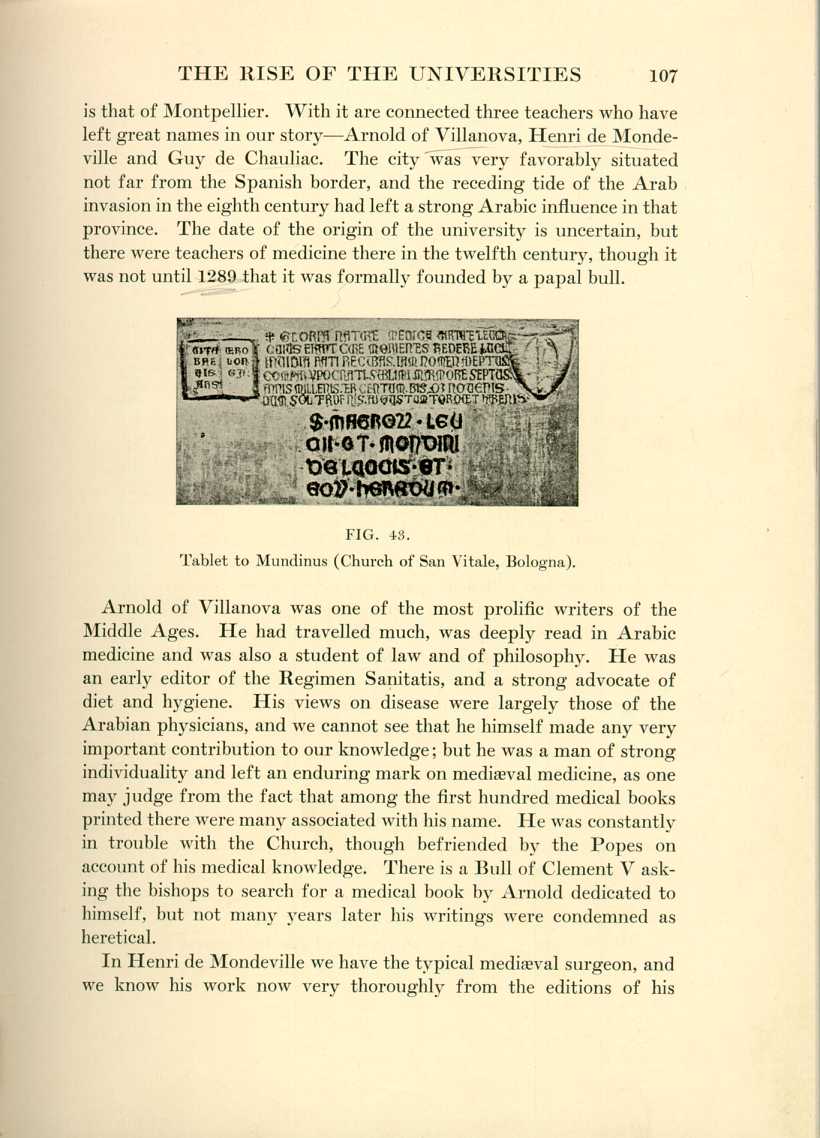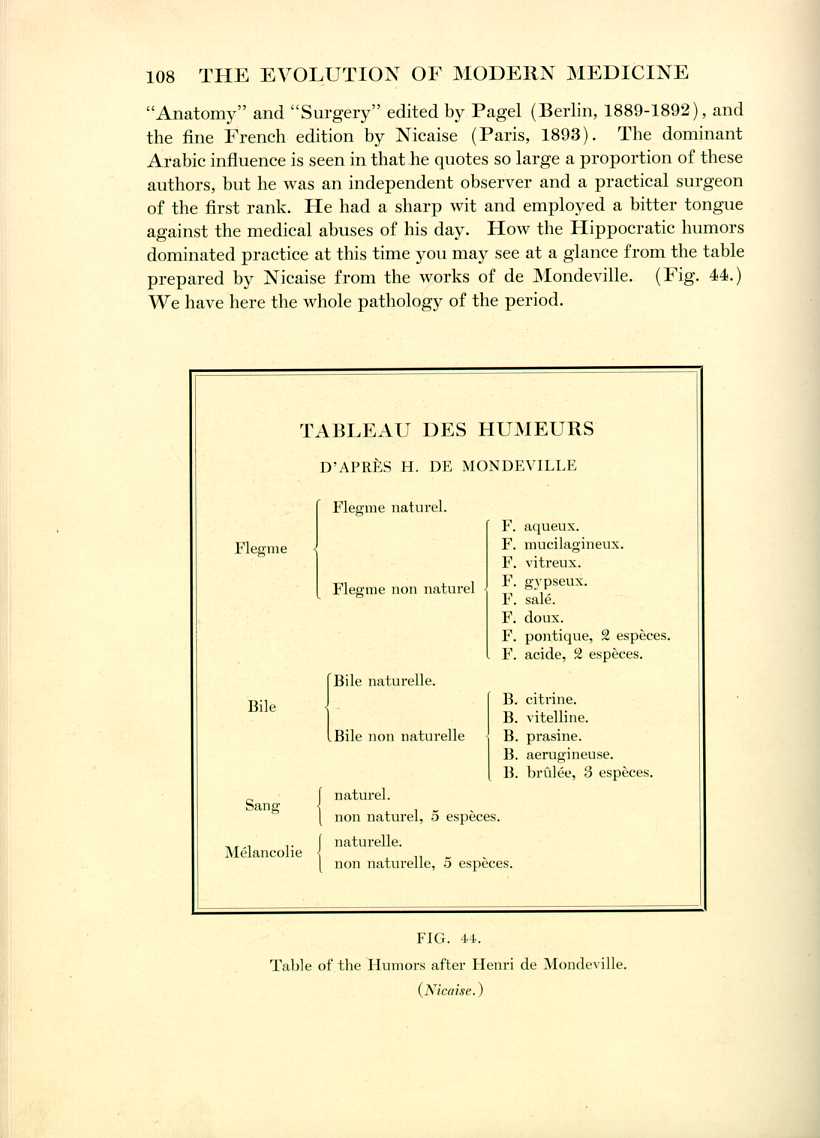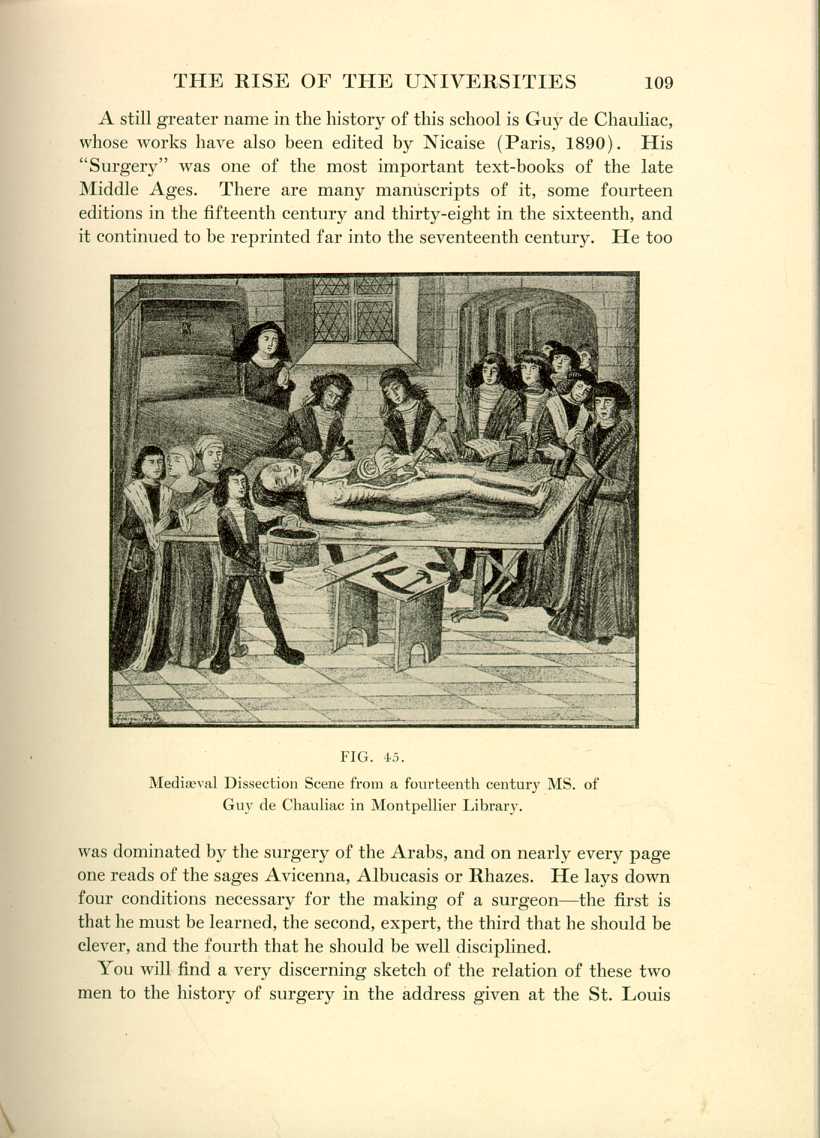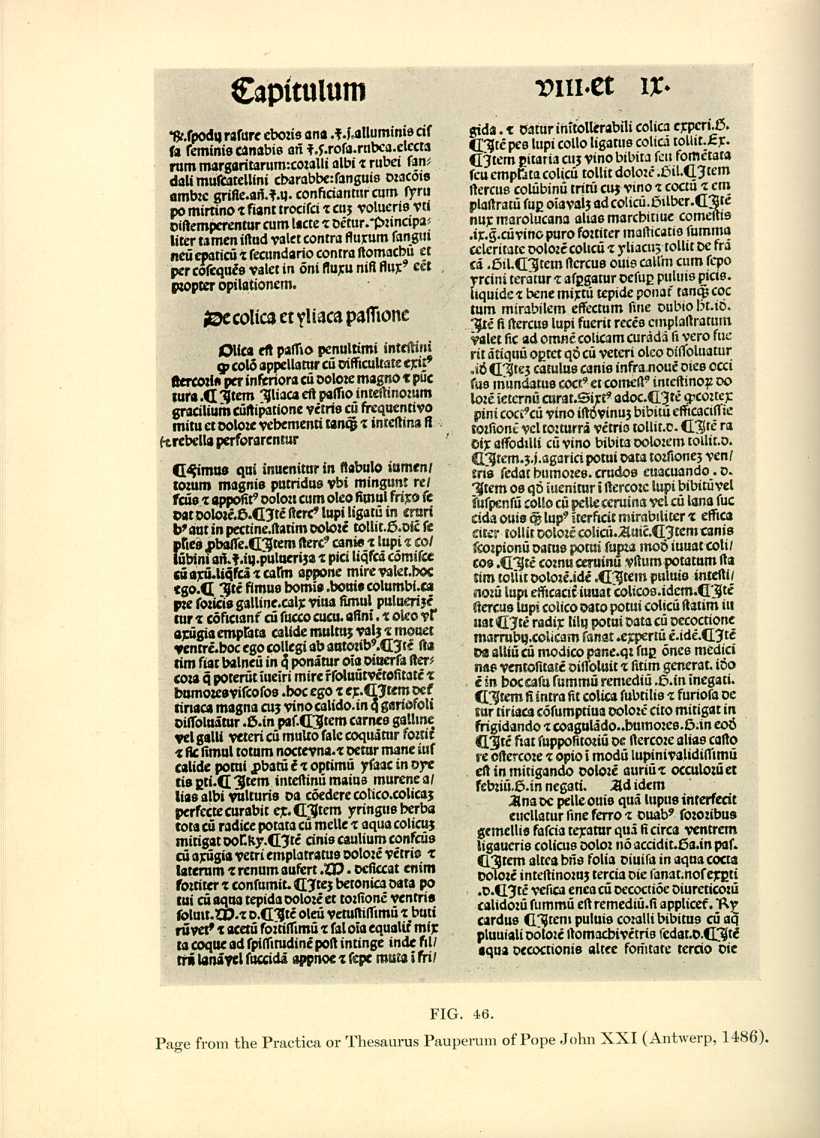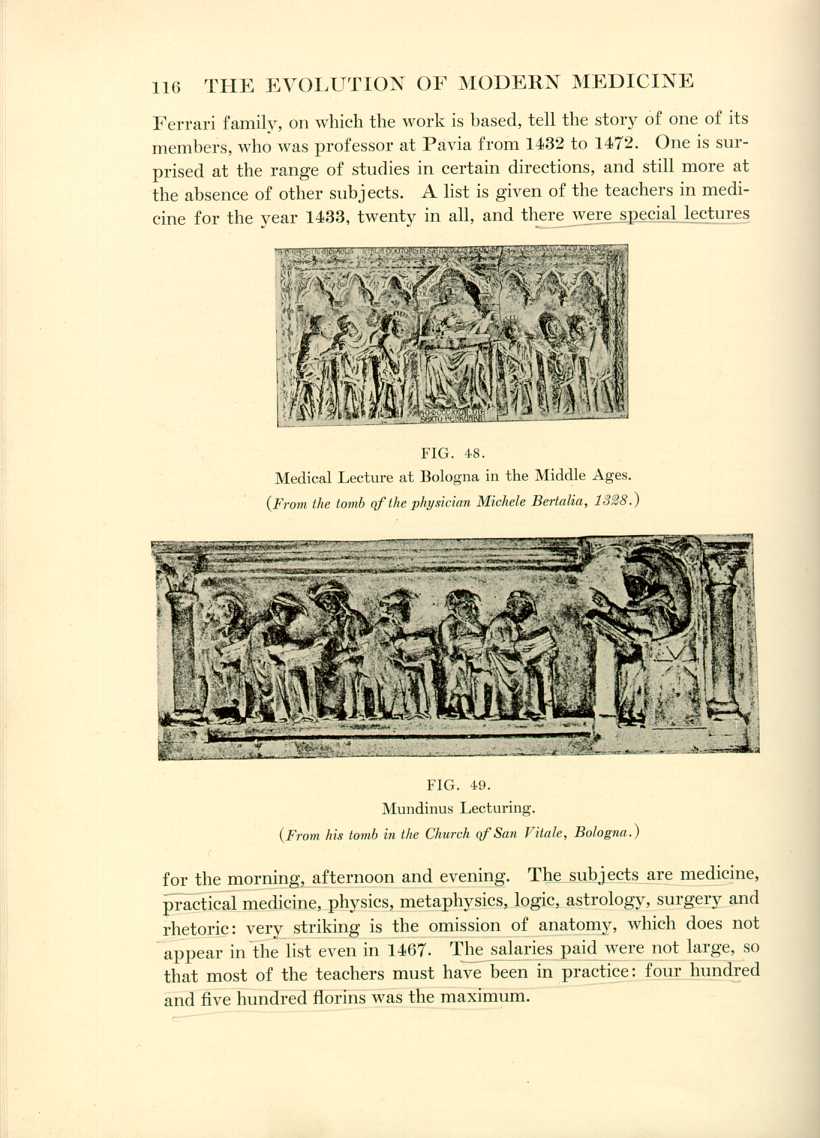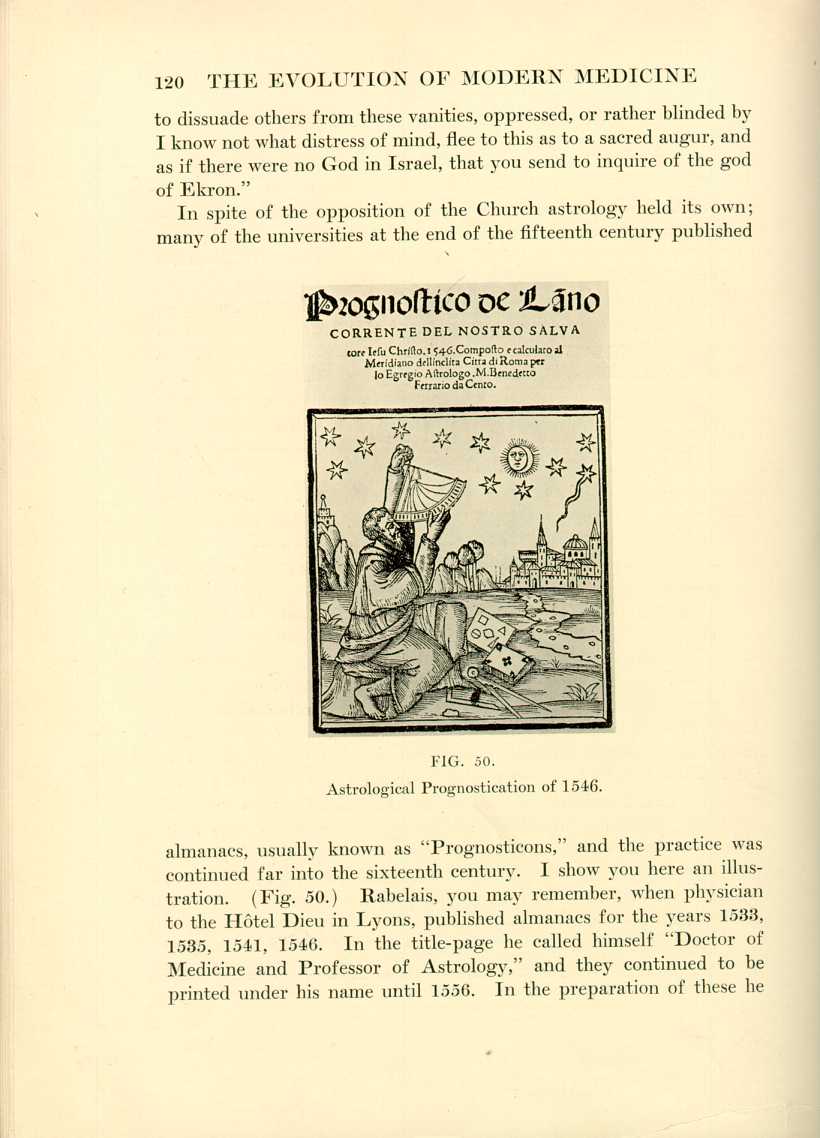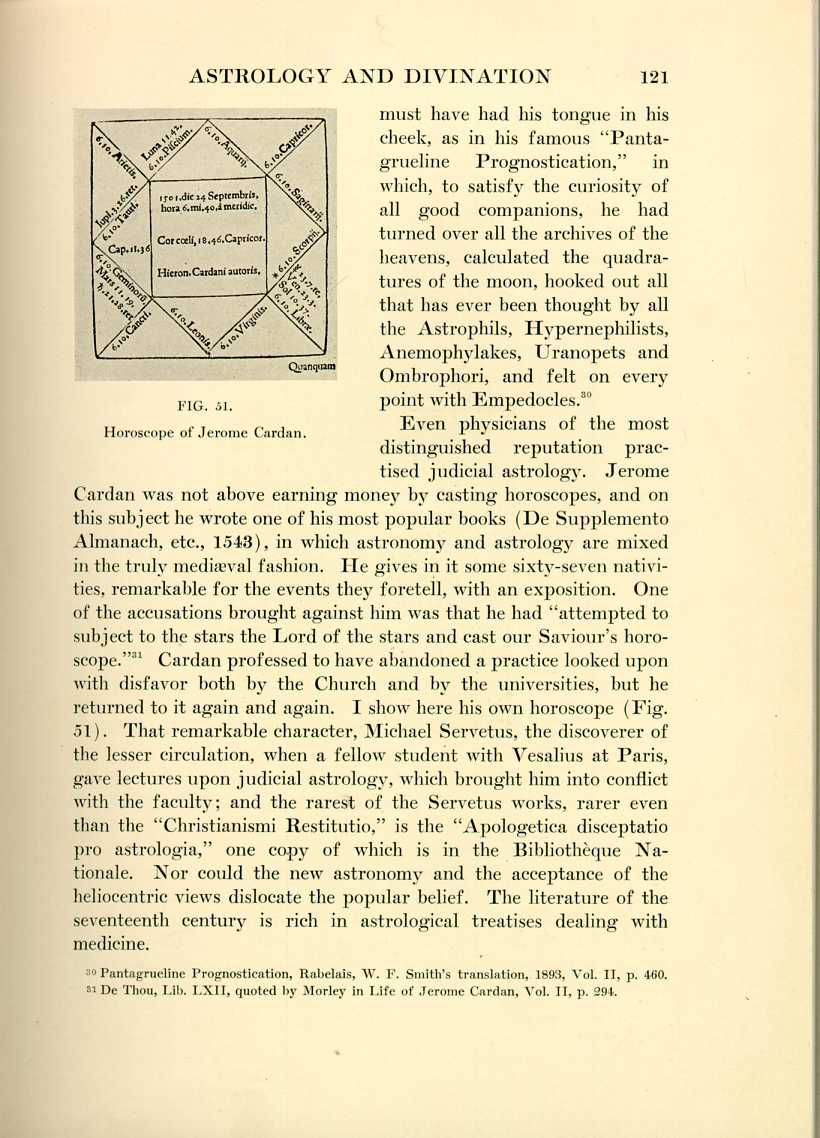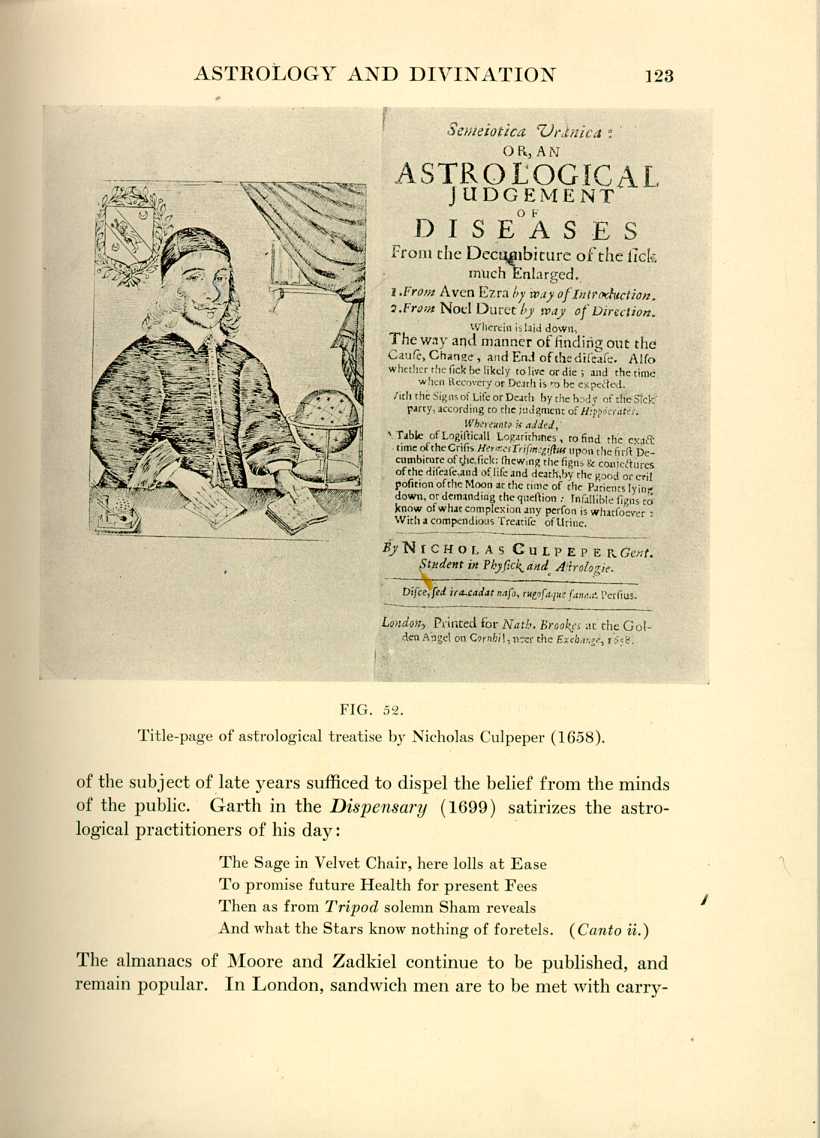| CHAPTER III The Evolution of Modern Medicine | ||
3. CHAPTER III
MEDIÆVAL MEDICINE
THERE are waste places of the earth which fill one with terror —not simply because they are waste; one has not such feelings in the desert nor in the vast solitude of the ocean. Very different is it where the desolation has overtaken a brilliant and flourishing product of man's head and hand. To know that
The Courts where Jamshýd gloried and drank deep
sends a chill to the heart, and one trembles with a sense of human instability. With this feeling we enter the Middle Ages. Following the glory that was Greece and the grandeur that was Rome, a desolation came upon the civilized world, in which the light of learning burned low, flickering almost to extinction. How came it possible that the gifts of Athens and of Alexandria were deliberately thrown away? For three causes. The barbarians shattered the Roman Empire to its foundations. When Alaric entered Rome in 410 A. D., ghastly was the impression made on the contemporaries; the Roman world shuddered in a titanic spasm (Lindner). The land was a garden of Eden before them, behind a howling wilderness, as is so graphically told in Gibbon's great history. Many of the most important centres of learning were destroyed, and for centuries Minerva and Apollo forsook the haunts of men. The other equally important cause was the change wrought by Christianity. The brotherhood of man, the care of the body, the gospel of practical virtues formed the essence of the teaching of the Founder—in these the Kingdom of Heaven was to be sought; in these lay salvation. But the world was very evil, all thought that the times were waxing late, and into men's minds entered as never before a conviction of the importance of the
Galen died about 200 A. D.; the high-water mark of the Renaissance, so far as medicine is concerned, was reached in the year 1542. In order to traverse this long interval intelligently, I will sketch certain great movements, tracing the currents of Greek thought, setting forth in their works the lives of certain great leaders, until we greet the dawn of our own day.
After flowing for more than a thousand years through the broad plain of Greek civilization, the stream of scientific medicine which we have been following is apparently lost in the morass of the Middle Ages; but, checked and blocked like the White Nile in the Soudan, three channels may be followed through the weeds of theological and philosophical speculation.
H. O. Taylor: The Mediæval Mind, 2 vols., Macmillan Co., New York, 1911. [New edition, 1920.]
Ibid., Vol. 1, p. 13: "Under their action [the Christian Fathers] the peoples of Western Europe, from the eighth to the thirteenth century, passed through a homogeneous growth, and evolved a spirit different from that of any other period of history—a spirit which stood in awe before its monitors divine and human, and deemed that knowledge was to be drawn from the storehouse of the past; which seemed to rely on everything except its sin-crushed self, and trusted everything except its senses; which in the actual looked for the ideal, in the concrete saw the symbol, in the earthly Church beheld the heavenly, and in fleshly joys discerned the devil's lures; which lived in the unreconciled opposition between the lust and vain-glory of earth and the attainment of salvation; which felt life's terror and its pitifulness, and its eternal hope; around which waved concrete infinitudes, and over which flamed the terror of darkness and the Judgment Day."
SOUTH ITALIAN SCHOOL
A WIDE stream is in Italy, where the "antique education never stopped, antique reminiscence and tradition never passed away, and the literary matter of the pagan past never faded from the consciousness of the more educated among the laity and clergy." [71] Greek was the language of South Italy and was spoken in some of its eastern towns until the thirteenth century. The cathedral and monastic
The Norman Kingdom of South Italy and Sicily was a meeting ground of Saracens, Greeks and Lombards. Greek, Arabic and Latin were in constant use among the people of the capital, and Sicilian scholars of the twelfth century translated directly from the Greek.
The famous "Almagest" of Ptolemy, the most important work of ancient astronomy, was translated from a Greek manuscript, as early as 1160, by a medical student of Salerno.[73]
About thirty miles southeast of Naples lay Salernum, which for centuries kept alight the lamp of the old learning, and became the centre of medical studies in the Middle Ages; well deserving its name of "Civitas Hippocratica." The date of foundation is uncertain, but
There are crowds of guests and travellers here;
Pilgrims and mendicant friars and traders
From the Levant, with figs and wine,
And bands of wounded and sick Crusaders,
Coming back from Palestine.
There were medical and surgical clinics, foundling hospitals, Sisters of Charity, men and women professors—among the latter the famous Trotula—and apothecaries. Dissections were carried out, chiefly upon animals, and human subjects were occasionally used. In the eleventh and twelfth centuries, the school reached its height, and that remarkable genius, Frederick II, laid down regulations for a preliminary study extending over three years, and a course in medicine for five years, including surgery. Fee tables and strict regulations as to practice were made; and it is specifically stated that the masters were to teach in the schools, theoretically and practically, under the authority of Hippocrates and Galen. The literature from the school had a far-reaching influence. One book on the anatomy of the pig illustrates the popular subject for dissection at that time. [74] The writings, which are numerous, have been collected by De Renzi. [75]
The "Antidotarium" of Nicolaus Salernitanus, about 1100, became the popular pharmacopœia of the Middle Ages, and many modern preparations may be traced to it.
The most prominent man of the school is Constantinus Africanus, a native of Carthage, who, after numerous journeys, reached Salernum about the middle of the eleventh century. He was familiar with the works both of the Greeks and of the Arabs, and it was largely through his translations that the works of Rhazes and Avicenna became known in the West.
One work above all others spread the fame of the school—the
passed into popular use, such as "Joy, temperance and repose Slam the door on the doctor's nose." A full account of the work and the various editions of it is given by Sir Alexander Croke, [76] and the Finlayson lecture (Glasgow Medical Journal, 1908) by Dr. Norman Moore gives an account of its introduction into the British Isles.
S. de Renzi: Collectio Salernitana, 5 vols., Naples, 1852-1859; P. Giacosa: Magistri Salernitani, Turin, 1901.
Regimen Sanitutis Salernitanum; a Poem on the Preservation of Health in Rhyming Latin Verse, Oxford, D. A. Talboys, 1830.
BYZANTINE MEDICINE
THE second great stream which carried Greek medicine to modern days runs through the Eastern Empire. Between the third century and the fall of Constantinople there was a continuous series of Byzantine
physicians whose inspiration was largely derived from the old Greek sources. The most distinguished of these was Oribasius, a voluminous compiler, a native of Pergamon and so close a follower of his great townsman that he has been called "Galen's ape." He left many works, an edition of which was edited by Bussemaker and Daremberg. Many facts relating to the older writers are recorded in his writings. He was a contemporary, friend as well as the physician,
Other important Byzantine writers were Aëtius and Alexander of Tralles, both of whom were strongly under the influence of Galen and Hippocrates. Their materia medica was based largely upon Dioscorides.
From Byzantium we have the earliest known complete medical manuscript, dating from the fifth century—a work of Dioscorides— one of the most beautiful in existence. It was prepared for Anicia Juliana, daughter of the Emperor of the East, and is now one of the great treasures of the Imperial Library at Vienna. [77] From those early centuries till the fall of Constantinople there is very little of interest medically. A few names stand out prominently, but it is mainly a blank period in our records. Perhaps one man may be mentioned, as he had a great influence on later ages—Actuarius, who lived about 1300, and whose book on the urine laid the foundation of much of the popular uroscopy and water-casting that had such a vogue in the sixteenth and seventeenth centuries. His work on the subject passed through a dozen Latin editions, but is best studied in Ideler's "Physici et medici Græci minores" (Berlin, 1841).
The Byzantine stream of Greek medicine had dwindled to a very tiny rill when the fall of Constantinople (1453) dispersed to the West many Greek scholars and many precious manuscripts.
It has been reproduced by Seatone de Vries, Leyden, 1905, Codices graeci et latini photographice depicti, Vol. X.
ARABIAN MEDICINE
THE third and by far the strongest branch of the Greek river reached the West after a remarkable and meandering course. The map before you (Fig. 35) shows the distribution of the Græco-Roman Christian world at the beginning of the seventh century. You will notice that Christianity had extended far eastwards, almost to China. Most of those eastern Christians were Nestorians and one of their important centres was Edessa, whose school of learning became so celebrated. Here in the fifth century was built one of the most celebrated hospitals of antiquity.
Now look at another map (Fig. 36) showing the same countries
about a century later. No such phenomenal change ever was made within so short space of time as that which thus altered the map of Asia and Europe at this period. Within a century, the Crescent had swept from Arabia through the Eastern Empire, over Egypt, North Africa and over Spain in the West, and the fate of Western Europe hung in the balance before the gates of Tours in 732. This time the barbaric horde that laid waste a large part of Christendom were a people that became deeply appreciative of all that was best in Græco-Roman civilization and of nothing more than of its sciences. The cultivation of medicine was encouraged by the Arabs in a very special way. Anyone wishing to follow the history of the medical profession among this remarkable people will find it admirably presented in Lucien Leclerc's "Histoire de la médecine arabe" (Paris, 1876). An excellent account is also given in Freind's well-known "History of Medicine" (London, 1725-1726). Here I can only indicate very briefly the course of the stream and its freightage.
With the rise of Christianity, Alexandria became a centre of bitter theological and political factions, the story of which haunts the memory of anyone who was so fortunate as to read in his youth Kingsley's "Hypatia." These centuries, with their potent influence of neoplatonism on Christianity, appear to have been sterile enough in medicine. I have already referred to the late Greeks, Aëtius and Alexander of Tralles. The last of the Alexandrians was a remarkable man, Paul of Ægina, a great name in medicine and in surgery, who lived in the early part of the seventh century. He also, like Oribasius, was a great compiler. In the year 640, the Arabs took Alexandria, and for the third time a great library was destroyed in the "first city of the West." Shortly after the conquest of Egypt, Greek works were translated into Arabic, often through the medium of Syriac, particularly certain of Galen's books on medicine, and chemical writings, which appear to have laid the foundation of Arabian knowledge on this subject.
Through Alexandria then was one source: but the special development of the Greek science and of medicine took place in the ninth century under the Eastern Caliphates. Let me quote here a couple of sentences from Leclerc (Tome I, pp. 91-92):
"The world has but once witnessed so marvellous a spectacle as that presented by the Arabs in the ninth century. This pastoral people,
"At the end of the eighth century, their whole scientific possessions consisted of a translation of one medical treatise and some books on alchemy. Before the ninth century had run to its close, the Arabs were in possession of all the science of the Greeks; they had produced from their own ranks students of the first order, and had raised among their initiators men who, without them, would have been groping in the dark; and they showed from this time an aptitude for the exact sciences, which was lacking in their instructors, whom they henceforward surpassed."
It was chiefly through the Nestorians that the Arabs became acquainted with Greek medicine, and there were two famous families of translators, the Bakhtishuas and the Mesuës, both Syrians, and probably not very thoroughly versed in either Greek or Arabic. But the prince of translators, one of the finest figures of the century, was Honein, a Christian Arab, born in 809, whose name was Latinized as Joannitius. "The marvellous extent of his works, their excellence, their importance, the trials he bore nobly at the beginning of his career, everything about him arouses our interest and sympathy. If he did not actually create the Oriental renaissance movement, certainly no one played in it a more active, decided and fruitful part." [78] His industry was colossal. He translated most of the works of Hippocrates and Galen, Aristotle and many others. His famous "Introduction" or "Isagoge," a very popular book in the Middle Ages, is a translation of the "Microtegni" of Galen, a small hand-book, of which a translation is appended to Cholmeley's "John of Gaddesden." [79] The first printed edition of it appeared in 1475 [see page 127] at Padua.
The Mesuës also did great work, and translations of their compilations, particularly those of the younger Mesuë, were widely distributed in manuscript and were early printed (Venice, 1471) and frequently reprinted, even as late as the seventeenth century.
Leclerc gives the names of more than one hundred known translators who not only dealt with the physicians but with the Greek philosophers, mathematicians and astronomers. The writings of the physicians of India and of Persia were also translated into Arabic.
But close upon the crowd of translators who introduced the learning of Greece to the Arabians came original observers of the first rank, to a
few only of whom time will allow me to refer. Rhazes, so called from the name of the town (Rai) in which he was born, was educated at the great hospital at Bagdad in the second half of the ninth century. With a true Hippocratic spirit he made many careful observations on disease, and to him we owe the first accurate account of smallpox, which he differentiated from measles. This work was translated for the old Sydenham Society by W. A. Greenhill (1848), and the description given of the disease is well worth reading. He was a man of strong powers of observation, good sense and excellent judgment. His works were very popular, particularly the gigantic "Continens," one of the bulkiest of incunabula. The Brescia edition, 1486, a magnificent volume, extends over 588 pages and it must weigh more than seventeen pounds. It is an encyclopædia filled with extracts from the Greek and other writers, interspersed with memoranda of his own experiences. His "Almansor" was a very popular text-book, and one of the first to be printed. Book IX of "Almansor" (the name of the prince to whom it was addressed) with the title "De ægritudinibus a capite usque ad pedes," was a very favorite mediæval text-book. On
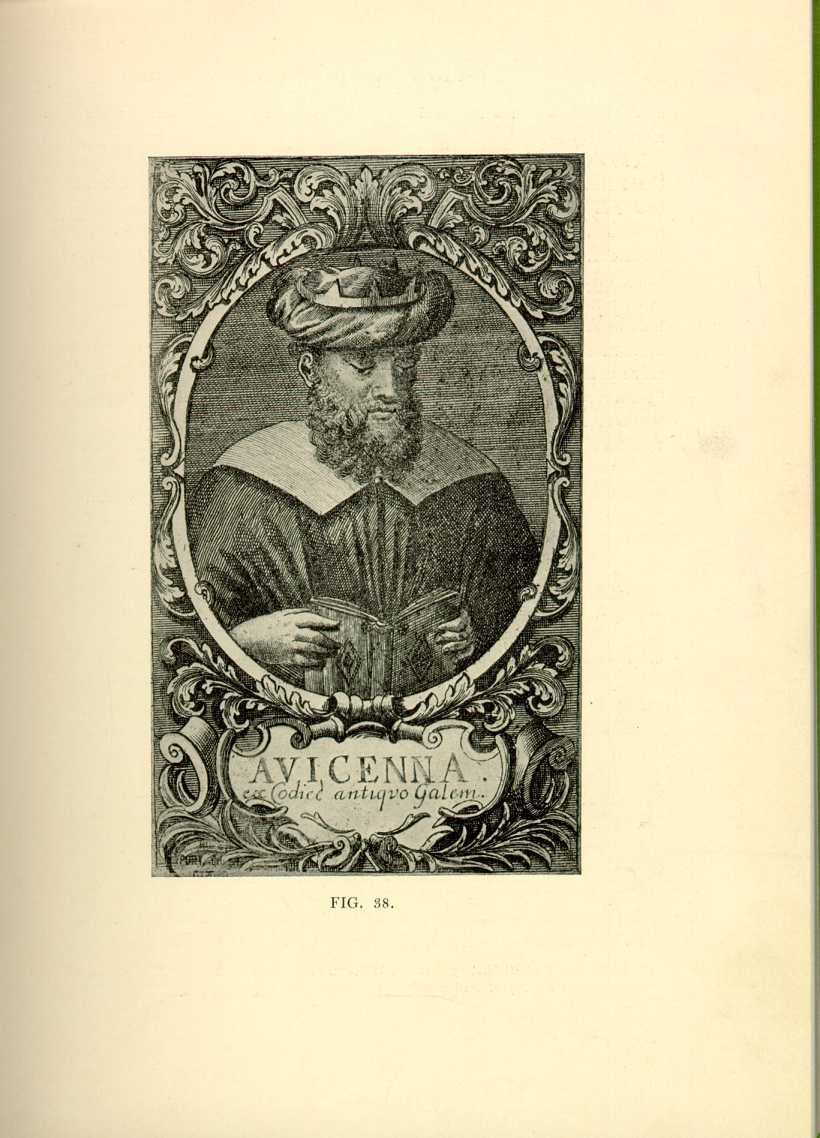
FIG. 38.
[Description: A black and white portrait of Avicenna.]
account of his zeal for study Rhazes was known as the "Experimentator."
The first of the Arabians, known throughout the Middle Ages as the Prince, the rival, indeed, of Galen, was the Persian Ibn Sina, better known as Avicenna, one of the greatest names in the history of medicine. Born about 980 A. D. in the province of Khorasan, near Bokhara, he has left a brief autobiography from which we learn something of his early years. He could repeat the Koran by heart when ten years old, and at twelve he had disputed in law and in logic. So that he found medicine was an easy subject, not hard and thorny like mathematics and metaphysics! He worked night and day, and could solve problems in his dreams. "When I found a difficulty," he says, "I referred to my notes and prayed to the Creator. At night, when weak or sleepy, I strengthened myself with a glass of wine." [80] He was a voluminous writer to whom scores of books are attributed, and he is the author of the most famous medical text-book ever written. It is safe to say that the "Canon" was a medical bible for a longer period than any other work. It "stands for the epitome of all precedent development, the final codification of all Græco-Arabic medicine. It is a hierarchy of laws liberally illustrated by facts which so ingeniously rule and are subject to one another, stay and uphold one another, that admiration is compelled for the sagacity of the great organiser who, with unparalleled power of systematisation, collecting his material from all sources, constructed so imposing an edifice of fallacy. Avicenna, according to his lights, imparted to contemporary medical science the appearance of almost mathematical accuracy, whilst the art of therapeutics, although empiricism did not wholly lack recognition, was deduced as a logical sequence from theoretical (Galenic and Aristotelian) premises. Is it, therefore, matter for surprise that the majority of investigators and practitioners should have fallen under the spell of this consummation of formalism and should have regarded the `Canon' as an infallible oracle, the more so in that the logical construction was impeccable and the premises, in the light of contemporary conceptions, passed for incontrovertible axioms?" [81]
Innumerable manuscripts of it exist: of one of the most beautiful, a Hebrew version (Bologna Library), I give an illustration (Fig. 39).
A Latin version was printed in 1472 and there are many later editions, the last in 1663. Avicenna was not only a successful writer, but the prototype of the successful physician who was at the same time statesman, teacher, philosopher and literary man. Rumor has it that he became dissipated, and a contemporary saying was that all his philosophy could not make him moral, nor all his physic teach him to preserve his health. He enjoyed a great reputation as a poet. I reproduce (Fig. 40) a page of a manuscript of one of his poems, which we have in the Bodleian Library. Prof. A. V. W. Jackson says that some of his verse is peculiarly Khayyamesque,
though he antedated Omar by a century. That "large Infidel" might well have written such a stanza as
I've solved all problems of this world's Estate,
From every snare of Plot and Guile set free,
Each bond resolved, saving alone Death's Fate.
His hymn to the Deity might have been written by Plato and rivals the famous one of Cleanthes.[82] A casual reader gets a very favorable impression of Avicenna. The story of his dominion over the schools in the Middle Ages is one of the most striking in our history. Perhaps we feel that Leclerc exaggerates when he says: "Avicenna is an intellectual phenomenon. Never perhaps has an example been seen of so precocious, quick and wide an intellect extending and asserting itself with so strange and indefatigable an activity." The touch of the man never reached me until I read some of his mystical and philosophical
shape, and surrounded by an unpretentious court. It was restored in 1877, but is again in need of repair. The illustration here shown (Fig. 41) is from a photograph sent by Dr. Neligan of Teheran. Though dead, the great Persian has still a large practice, as his tomb is much visited by pilgrims, among whom cures are said to be not uncommon.
The Western Caliphate produced physicians and philosophers almost as brilliant as those of the East. Remarkable schools of medicine were founded at Seville, Toledo and Cordova. The most famous of the professors were Averroës, Albucasis and Avenzoar. Albucasis was "the Arabian restorer of surgery." Averroës, called in the Middle Ages "the Soul of Aristotle" or "the Commentator," is better known today among philosophers than physicians. On the revival of Moslem orthodoxy he fell upon evil days, was persecuted as a free-thinker, and the saying is attributed to him—"Sit anima mea cum philosophic."
Arabian medicine had certain very definite characteristics: the basis was Greek, derived from translations of the works of Hippocrates and Galen. No contributions were made to anatomy, as dissections were prohibited, nor to physiology, and the pathology was practically that of Galen. Certain new and important diseases were described; a number of new and active remedies were introduced, chiefly from the vegetable kingdom. The Arabian hospitals were well organized and were deservedly famous. No such hospital exists today in Cairo as that which was built by al-Mansur Gilafun in 1283. The description of it by Makrizi, quoted by Neuburger,[84] reads like that of a twentieth century institution with hospital units.
It was in the domain of chemistry that the Arabs made the greatest advances. You may remember that, in Egypt, chemistry had already made considerable strides, and I alluded to Prof. Elliot Smith's view that one of the great leaps in civilization was the discovery in the Nile Valley of the metallurgy of copper. In the brilliant period of the Ptolemies, both chemistry and pharmacology were studied, and it seems not improbable that, when the Arabs took Alexandria in the year 640, there were still many workers in these subjects.
The most famous of those early Arabic writers is the somewhat mythical Geber, who lived in the first half of the eighth century, and whose writings had an extraordinary influence throughout the Middle Ages. The whole story of Geber is discussed by Berthelot in his "La chimie au moyen âge" (Paris, 1896).
The transmission of Arabian science to the Occident began with the Crusades, though earlier a filtering of important knowledge in mathematics and astronomy had reached Southern and Middle Europe through Spain. Among the translators several names stand out prominently. Gerbert, who became later Pope Sylvester II, is said to have given us our present Arabic figures. You may read the story of his remarkable life in Taylor,[85] who says he was "the first mind of his time, its greatest teacher, its most eager learner, and most universal scholar." But he does not seem to have done much directly for medicine.
The Græco-Arabic learning passed into Europe through two sources. As I have already mentioned, Constantinus Africanus, a North African Christian monk, widely travelled and learned in languages, came to Salernum and translated many works from Arabic into Latin, particularly those of Hippocrates and Galen. The "Pantegni" of the latter became one of the most popular text-books of the Middle Ages. A long list of other works which he translated is given by Steinschneider.[86] It is not unlikely that Arabic medicine had already found its way to Salernum before the time of Constantine, but the influence of his translations upon the later Middle Ages was very great.
The second was a more important source through the Latin translators in Spain, particularly in Toledo, where, from the middle of the twelfth till the middle of the thirteenth century, an extraordinary number of Arabic works in philosophy, mathematics and astronomy were translated. Among the translators, Gerard of Cremona is prominent, and has been called the "Father of Translators." He was one of the brightest intelligences of the Middle Ages, and did a work of the first importance to science, through the extraordinary variety of material he put in circulation. Translations, not only of the medical writers, but of an indiscriminate crowd of authors in philosophy and general literature, came from his pen. He furnished one of the first translations of the famous "Almagest" of Ptolemy, which opened the eyes of his contemporaries to the value of the Alexandrian astronomy. [87] Leclerc gives a list of seventy-one works from his hand.
Many of the translators of the period were Jews, and many of the works were translated from Hebrew into Latin. For years Arabic had been the learned language of the Jews, and in a large measure it was through them that the Arabic knowledge and the translations passed into South and Central Europe.
The Arab writer whose influence on mediæval thought was the most profound was Averroës, the great commentator on Aristotle.
Traités mystiques d'Abou Ali al-Hosain b. Abdallah b. Sina ou d'Avicenne par M. A. F. Mehren, Leyden, E. J. Brill, Fasc. I-IV, 1889-1899.
"I have founded this institution for my equals and for those beneath me, it is intended for rulers and subjects, for soldiers and for the emir, for great and small, freemen and slaves, men and women." "He ordered medicaments, physicians and everything else that could be required by anyone in any form of sickness; placed male and female attendants at the disposal of the patients, determined their pay, provided beds for patients and supplied them with every kind of covering that could be required in any complaint. Every class of patient was accorded separate accommodation: the four halls of the hospital were set apart for those with fever and similar complaints; one part of the building was reserved for eye-patients, one for the wounded, one for those suffering from diarrhoea, one for women; a room for convalescents was divided into two parts, one for men and one for women. Water was laid on to all these departments. One room was set apart for cooking food, preparing medicine and cooking syrups, another for the compounding of confections, balsams, eye-salves, etc. The head-physician had an apartment to himself wherein he delivered medical lectures. The number of patients was unlimited, every sick or poor person who came found admittance, nor was the duration of his stay restricted, and even those who were sick at home were supplied with every necessity."—Makrizi.
"In later times this hospital was much extended and improved. The nursing was admirable and no stint was made of drugs and appliances; each patient was provided with means upon leaving so that he should not require immediately to undertake heavy work." Neuburger: History of Medicine, Vol. 1, p. 378.
THE RISE OF THE UNIVERSITIES
THE most striking intellectual phenomenon of the thirteenth century is the rise of the universities. The story of their foundation is fully stated in Rashdall's great work (Universities of Europe in the Middle Ages, Oxford, 1895). Monastic and collegiate schools, seats of learning like Salernum, student guilds as at Bologna, had tried to meet the educational needs of the age. The word "university" literally means an association, and was not at first restricted to learned bodies. The origin appears to have been in certain guilds of students formed for mutual protection associated at some place specially favorable for study—the attraction generally being a famous teacher. The University of Bologna grew up about guilds formed by students of law, and at Paris, early in the twelfth century, there were communities of teachers, chiefly in philosophy and theology. In this way arose two different types of mediæval university. The universities of Northern Italy were largely controlled by students, who were grouped in different "nations." They arranged the lectures and had control of the appointment of teachers. On the other hand, in the universities founded on the Paris model the masters had control of the studies, though the students, also in nations, managed their own affairs.
Two universities have a special interest at this period in connection with the development of medical studies, Bologna and Montpellier. At the former the study of anatomy was revived. In the knowledge of the structure of the human body no advance had been made for more than a thousand years—since Galen's day. In the process of translation from Greek to Syriac, from Syriac to Arabic, from Arabic to Hebrew, and from Hebrew or Arabic to Latin, both the form and thought of the old Greek writers were not infrequently confused and often even perverted, and Galen's anatomy had suffered severely in
first citizen of Bologna and a public benefactor exempt from the payment of taxes. That he should have acquired wealth is not surprising if his usual fees were at the rate at which he charged Pope Honorius IV, i.e., two hundred florins a day, besides a "gratification" of six thousand florins.
The man who most powerfully influenced the study of medicine in
I have already referred to the study of medicine by women at Salernum. Their names are also early met with in the school of Bologna. Mundinus is said to have had a valuable assistant, a young girl, Alessandra Giliani, an enthusiastic dissector, who was the first to practice the injection of the blood vessels with colored liquids. She died, consumed by her labors, at the early age of nineteen, and her monument is still to be seen.
Bologna honored its distinguished professors with magnificent tombs, sixteen or seventeen of which, in a wonderful state of preservation, may still be seen in the Civic Museum. That of Mundinus also exists—a sepulchral bas-relief on the wall of the Church of San Vitale at Bologna.[88]
The other early mediæval university of special interest in medicine
Arnold of Villanova was one of the most prolific writers of the Middle Ages. He had travelled much, was deeply read in Arabic medicine and was also a student of law and of philosophy. He was an early editor of the Regimen Sanitatis, and a strong advocate of diet and hygiene. His views on disease were largely those of the Arabian physicians, and we cannot see that he himself made any very important contribution to our knowledge; but he was a man of strong individuality and left an enduring mark on mediæval medicine, as one may judge from the fact that among the first hundred medical books printed there were many associated with his name. He was constantly in trouble with the Church, though befriended by the Popes on account of his medical knowledge. There is a Bull of Clement V asking the bishops to search for a medical book by Arnold dedicated to himself, but not many years later his writings were condemned as heretical.
In Henri de Mondeville we have the typical mediæval surgeon, and we know his work now very thoroughly from the editions of his
TABLEAU DES HUMEURS
D'APRÈS H. DE MONDEVILLE
Flegme naturel.
Flegme}
Flegme non naturel}
F. aqueux.
F. mucilagineux.
F. vitreux.
F salé.
F. doux.
F. pontique, 2 espèces.
F. acide, 2 especes.
Bile naturelle.
Bile}
Bile non naturelle}
B. citrine.
B. vitelline
B. praline.
B. aerugineuse.
B. brûlée, 3 espèces.
Sang}
naturel.
non naturel, 5 espèces.
Mélancolie}
naturelle.
non naturelle, 5 espèces.
A still greater name in the history of this school is Guy de Chauliac, whose works have also been edited by Nicaise (Paris, 1890). His "Surgery" was one of the most important text-books of the late Middle Ages. There are many manuscripts of it, some fourteen editions in the fifteenth century and thirty-eight in the sixteenth, and it continued to be reprinted far into the seventeenth century. He too
was dominated by the surgery of the Arabs, and on nearly every page one reads of the sages Avicenna, Albucasis or Rhazes. He lays down four conditions necessary for the making of a surgeon—the first is that he must be learned, the second, expert, the third that he should be clever, and the fourth that he should be well disciplined.
You will find a very discerning sketch of the relation of these two men to the history of surgery in the address given at the St. Louis
One other great mediæval physician may be mentioned, Peter of Abano (a small town near Padua, famous for its baths). He is the first in a long line of distinguished physicians connected with the great school of Padua. Known as "the Conciliator," from his attempt to reconcile the diverse views on philosophy and medicine, he had an extraordinary reputation as a practitioner and author, the persistence of which is well illustrated by the fact that eight of the one hundred and eighty-two medical books printed before 1481 were from his pen. He seems to have taught medicine in Paris, Bologna and Padua. He was a devoted astrologer, had a reputation among the people as a magician and, like his contemporary, Arnold of Villanova, came into conflict with the Church and appears to have been several times before the Inquisition; indeed it is said that he escaped the stake only by a timely death. He was a prolific commentator on Aristotle, and his exposition of the "problems" had a great vogue. The early editions of his texts are among the most superb works ever printed. He outlived his reputation as a magician, and more than a century after his death Frederick, Duke of Urbino, caused his effigies to be set up over the gate of the palace at Padua with this inscription:
PETRUS APONUS PATAVINUS PHILOSOPHIÆ MEDICINÆQUE SCIENTISSIMUS, OB IDQUE, CONCILIATORIS NOMEN ADEPTUS, ASTROLOGIÆ VERO ADEO PERITUS, UT IN MAGIÆ SUSPICIONEM INCIDERIT, FALSOQUE DE HÆRESI POSTULATUS, ABSOLUTUS FUERIT.[90]
It is said that Abano caused to be painted the astronomical figures in the great hall of the palace at Padua.
One characteristic of mediæval medicine is its union with theology,
For our purpose two beacons illuminate the spirit of the thirteenth century in its outlook on man and nature. Better than Abelard or St. Thomas Aquinas, and much better than any physicians, Albertus Magnus and Roger Bacon represent the men who were awake to greet the rising of the sun of science. What a contrast in their lives and in their works! The great Dominican's long life was an uninterrupted triumph of fruitful accomplishment—the titanic task he set himself was not only completed but was appreciated to the full by his own generation—a life not only of study and teaching, but of practical piety. As head of the order in Germany and Bishop of Regensburg, he had wide ecclesiastical influence; and in death he left a memory equalled only by one or two of his century, and excelled only by his great pupil, Thomas Aquinas. There are many Alberts in history—the Good, the Just, the Faithful—but there is only one we call "Magnus" and he richly deserved the name. What is his record? Why do we hold his name in reverence today?
Albertus Magnus was an encyclopædic student and author, who took all knowledge for his province. His great work and his great ambition was to interpret Aristotle to his generation. Before his day, the Stagirite was known only in part, but he put within the reach of his contemporaries the whole science of Aristotle, and imbibed no small part of his spirit. He recognized the importance of the study of nature, even of testing it by way of experiment, and in the long years that had elapsed since Theophrastus no one else, except Dioscorides, had made so thorough a study of botany. His paraphrases of the natural history books of Aristotle were immensely popular, and served as a basis for all subsequent studies. Some of his medical works had an extraordinary vogue, particularly the "De Secretis Mulierum" and the "De Virtutibus Herbarum," but there is some doubt as to the authorship of the first named, although Jammy and Borgnet include it in the collected editions of his works. So fabulous was his learning that he was suspected of magic and comes in Naudé's list of
the wise men who have unjustly been reputed magicians. Ferguson tells[91] that "there is in actual circulation at the present time a chapbook . . . containing charms, receipts, sympathetical and magical cures for man and animals, . . . which passes under the name of Albertus." But perhaps the greatest claim of Albertus to immortality is that he was the teacher and inspirer of Thomas Aquinas, the man who undertook the colossal task of fusing Aristotelian philosophy with Christian theology, and with such success that the "angelic doctor" remains today the supreme human authority of the Roman Catholic Church.
A man of much greater interest to us from the medical point of view is Roger Bacon and for two reasons. More than any other mediæval mind he saw the need of the study of nature by a new method. The man who could write such a sentence as this: "Experimental science has three great prerogatives over other sciences; it verifies conclusions by direct experiment; it discovers truth which they never otherwise would reach; it investigates the course of nature and opens to us a knowledge of the past and of the future," is mentally of our day and generation. Bacon was born out of due time, and his contemporaries had little sympathy with his philosophy, and still less with his mechanical schemes and inventions. From the days of the Greeks, no one had had so keen an appreciation of what experiment meant in the development of human knowledge, and he was obsessed with the idea, so commonplace to us, that knowledge should have its utility and its practical bearing. "His chief merit is that he was one of the first to point the way to original research—as opposed to the acceptance of an authority—though he himself still lacked the means of pursuing this path consistently. His inability to satisfy this impulse led to a sort of longing, which is expressed in the numerous passages in his works where he anticipates man's greater mastery over nature." [92]
Bacon wrote a number of medical treatises, most of which remain in manuscript. His treatise on the "Cure of Old Age and the Preservation of Youth" was printed in English in 1683.[93] His authorities
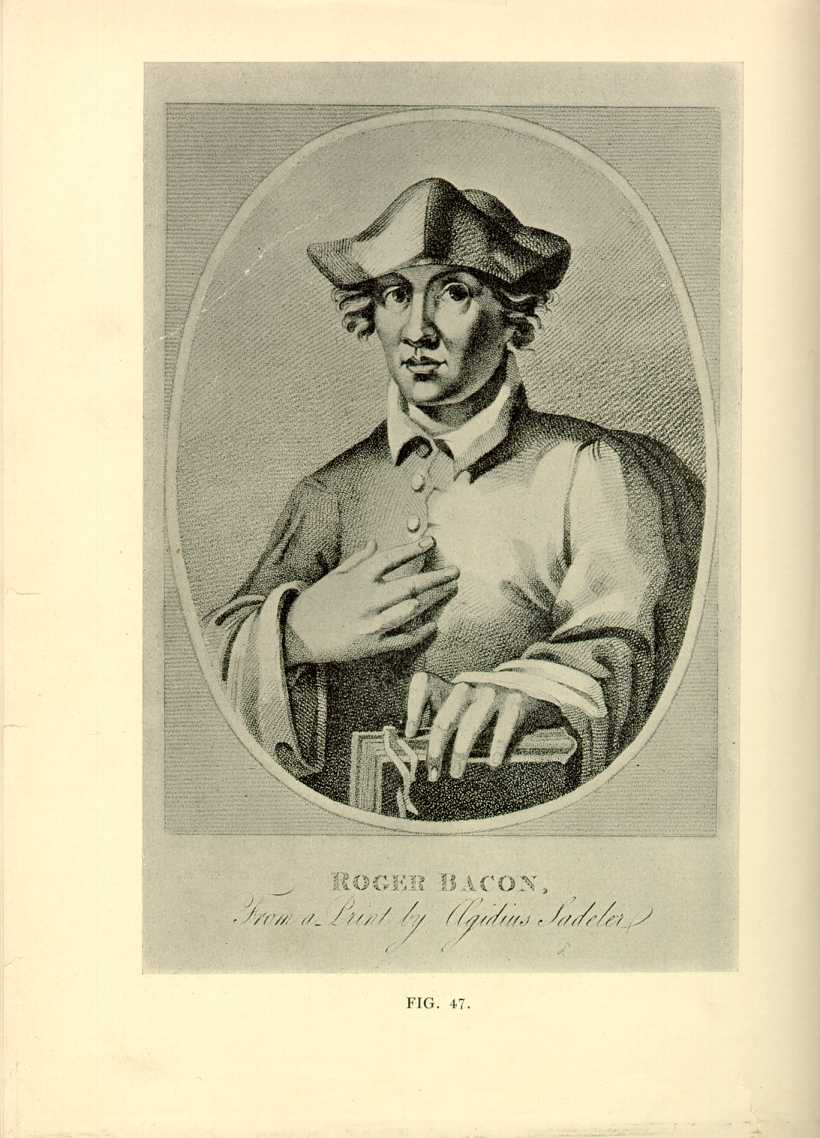
FIG. 47.
[Description: A black and white illustrated portrait of Roger
Bacon.]
were largely Arabian. One of his manuscripts is "On the Bad Practices of Physicians." On June 10, 1914, the eve of his birth, the septencentenary of Roger Bacon will be celebrated by Oxford, the university of which he is the most distinguished ornament. His unpublished MSS. in the Bodleian will be issued by the Clarendon Press [1915-1920], and it is hoped that his unpublished medical writings will be included.
What would have been its fate if the mind of Europe had been ready for Roger Bacon's ferment, and if men had turned to the profitable studies of physics, astronomy and chemistry instead of wasting centuries over the scholastic philosophy and the subtleties of Duns Scotus, Abelard and Thomas Aquinas? Who can say? Make no mistake about the quality of these men—giants in intellect, who have had their place in the evolution of the race; but from the standpoint of man struggling for the mastery of this world they are like the members of Swift's famous college "busy distilling sunshine from cucumbers." I speak, of course, from the position of the natural man, who sees for his fellows more hope from the experiments of Roger Bacon than from the disputations of philosophy on the "Instants, Familiarities, Quiddities and Relations," which so roused the scorn of Erasmus.
For these figures and for points relating to the old school at Bologna see F. G. Cavezza: Le Scuole dell' antico Studio Bolognese, Milano, 1896.
Naudé: History of Magick, London, 1657, p. 182, or the original: Apologie pour les grands hommes soupĉonnez de magic, e.g., ed. Amst., 1719, p. 275.
Dannemann: Die Naturwissenschaften in ihrer Entwicklung und in ibrem Zusammenhange, Leipzig, 1910, Vol. I, pp. 278-279.
It may be interesting to note the three causes to which he attributes old age: "As the World waxeth old, Men grow old with it: not by reason of the Age of the World, but because of the great Increase of living Creatures, which infect the very Air, that every way encompasseth us, and Through our Negligence in ordering our Lives, and That great Ignorance of the Properties which are in things conducing to Health, which might help a disordered way of Living, and might supply the defect of due Government."
MEDIÆVAL MEDICAL STUDIES
IT will be of interest to know what studies were followed at a mediæval university. At Oxford, as at most of the continental universities, there were three degrees, those of Bachelor, Licentiate and Doctor. The books read were the "Tegni" of Galen, the "Aphorisms" of Hippocrates, the "De Febribus" of Isaac and the "Antidotarium" of Nicolaus Salernitanus: if a graduate in arts, six years' study in all was required, in other faculties, eight. One gets very full information on such matters from a most interesting book, "Une Chaire de Médecine au XVe. Siècle," by Dr. Ferrari (Paris, 1899). The University of Pavia was founded in 1361, and like most of those in Italy was largely frequented by foreigners, who were arranged, as usual, according to their nationalities; but the students do not appear to have controlled the university quite so much as at Bologna. The documents of the
for the morning, afternoon and evening. The subjects are medicine, practical medicine, physics, metaphysics, logic, astrology, surgery and rhetoric: very striking is the omission of anatomy, which does not appear in the list even in 1467. The salaries paid were not large, so that most of the teachers must have been in practice: four hundred and five hundred florins was the maximum.
The dominance of the Arabians is striking. In 1467, special lectures were given on the "Almansor" of Rhazes, and in the catalogue of the Ferrari's library more than one half of the books are Arabian commentaries on Greek medicine. Still more striking evidence of their influence is found in the text-book of Ferrari, which was printed in 1471 and had been circulated earlier in MS. In it Avicenna is quoted more than 3000 times, Rhazes and Galen 1000, Hippocrates only 140 times. Professor Ferrari was a man who played an important rôle in the university, and had a large consultation practice. You will be interested to know what sort of advice he gave in special cases. I have the record of an elaborate consultation written in his own hand, from which one may gather what a formidable thing it was to fall into the hands of a mediæval physician. Signor John de Calabria had a digestive weakness of the stomach, and rheumatic cerebral disease, combined with superfluous heat and dryness of the liver and multiplication of choler. There is first an elaborate discussion on diet and general mode of life; then he proceeds to draw up certain light medicines as a supplement, but it must have taken an extensive apothecary's shop to turn out the twenty-two prescriptions designed to meet every possible contingency.
One of the difficulties in the early days of the universities was to procure good MSS. In the Paris Faculty, the records of which are the most complete in Europe, there is an inventory for the year 1395 which gives a list of twelve volumes, nearly all by Arabian authors. [94] Franklin gives an interesting incident illustrating the rarity of medical MSS. at this period. Louis XI, always worried about his health, was anxious to have in his library the works of Rhazes. The only copy available was in the library of the medical school. The manuscript was lent, but on excellent security, and it is nice to know that it was returned.
It is said that one of the special advantages that Montpellier had over Paris was its possession of so many important MSS., particularly those of the Arabian writers. Many "Compendia" were written containing extracts from various writers, and no doubt these were extensively copied and lent or sold to students. At Bologna and Padua, there were regulations as to the price of these MSS. The university controlled the production of them, and stationers were
MEDIÆVAL PRACTICE
THE Greek doctrine of the four humors colored all the conceptions of disease; upon their harmony alone it was thought that health depended. The four temperaments, sanguine, phlegmatic, bilious and melancholic, corresponded with the prevalence of these humors. The body was composed of certain so-called "naturals," seven in number— the elements, the temperaments, the humors, the members or parts, the virtues or faculties, the operations or functions and the spirits. Certain "non-naturals," nine in number, preserved the health of the body, viz.) air, food and drink, movement and repose, sleeping and waking, excretion and retention, and the passions. Disease was due usually to alterations in the composition of the humors, and the indications for treatment were in accordance with these doctrines. They were to be evacuated, tenuated, cooled, heated, purged or strengthened. This humoral doctrine prevailed throughout the Middle Ages, and reached far into modern times—indeed, echoes of it are still to be heard in popular conversations on the nature of disease.
The Arabians were famous for their vigor and resource in matters of treatment. Bleeding was the first resort in a large majority of all diseases. In the "Practice" of Ferrari there is scarcely a malady for which it is not recommended. All remedies were directed to the regulation of the six non-naturals, and they either preserved health, cured the disease or did the opposite. The most popular medicines were derived from the vegetable kingdom, and as they were chiefly those recommended by Galen, they were, and still are, called by his name. Many important mineral medicines were introduced by the Arabians, particularly mercury, antimony, iron, etc. There were in addition scores of substances, the parts or products of animals, some harmless, others salutary, others again useless and disgusting. Minor surgery was in the hands of the barbers, who performed all the minor operations, such as bleeding; the more important operations, few in number, were performed by surgeons.
ASTROLOGY AND DIVINATION
AT this period astrology, which included astronomy, was everywhere taught. In the "Gouernaunce of Prynces, or Pryvete of Pryveties," translated by James Yonge, 1422,[95] there occurs the statement: "As Galian the lull wies leche Saith and Isoder the Gode clerk, hit witnessith that a man may not perfitely can the sciens and craft of Medissin but yef he be an astronomoure."
We have seen how the practice of astrology spread from Babylonia and Greece throughout the Roman Empire. It was carried on into the Middle Ages as an active and aggressive cult, looked upon askance at times by the Church, but countenanced by the courts, encouraged at the universities, and always by the public. In the curriculum of the mediæval university, astronomy made up with music, arithmetic and geometry the Quadrivium. In the early faculties, astronomy and astrology were not separate, and at Bologna, in the early fourteenth century, we meet with a professorship of astrology. [96] One of the duties of this salaried professor, was to supply "judgements" gratis for the benefit of enquiring students, a treacherous and delicate assignment, as that most distinguished occupant of the chair at Bologna, Cecco d'Ascoli, found when he was burned at the stake in 1357, a victim of the Florentine Inquisition.[97]
Roger Bacon himself was a warm believer in judicial astrology and in the influence of the planets, stars and comets on generation, disease and death.
Many of the stronger minds of the Renaissance broke away from the follies of the subject. Thus Cornelius Agrippa in reply to the request of a friar to consult the stars on his behalf says: [98] "Judicial astrology is nothing more than the fallacious guess of superstitious men, who have founded a science on uncertain things and are deceived by it: so think nearly all the wise; as such it is ridiculed by some most noble philosophers; Christian theologians reject it, and it is condemned by sacred councils of the Church. Yet you, whose office it is
In spite of the opposition of the Church astrology held its own; many of the universities at the end of the fifteenth century published
almanacs, usually known as "Prognosticons," and the practice was continued far into the sixteenth century. I show you here an illustration. (Fig. 50.) Rabelais, you may remember, when physician to the Hôtel Dieu in Lyons, published almanacs for the years 1533, 1535, 1541, 1546. In the title-page he called himself "Doctor of Medicine and Professor of Astrology," and they continued to be printed under his name until 1556. In the preparation of these he
Even physicians of the most distinguished reputation practised judicial astrology. Jerome
Cardan was not above earning money by casting horoscopes, and on this subject he wrote one of his most popular books (De Supplemento Almanach, etc., 1543), in which astronomy and astrology are mixed in the truly mediæval fashion. He gives in it some sixty-seven nativi-ties, remarkable for the events they foretell, with an exposition. One of the accusations brought against him was that he had "attempted to subject to the stars the Lord of the stars and cast our Saviour's horoscope."[100] Cardan professed to have abandoned a practice looked upon with disfavor both by the Church and by the universities, but he returned to it again and again. I show here his own horoscope (Fig. 51). That remarkable character, Michael Servetus, the discoverer of the lesser circulation, when a fellow student with Vesalius at Paris, gave lectures upon judicial astrology, which brought him into conflict with the faculty; and the rarest of the Servetus works, rarer even than the "Christianismi Restitutio," is the "Apologetica disceptatio pro astrologia," one copy of which is in the Bibliothèque Nationale. Nor could the new astronomy and the acceptance of the heliocentric views dislocate the popular belief. The literature of the seventeenth century is rich in astrological treatises dealing with medicine.
No one has ever poured such satire upon the mantic arts as did Rabelais in chapter twenty-five of the third book of "Pantagruel." Panurge goes to consult Her Trippa—the famous Cornelius Agrippa, whose opinion of astrology has already been quoted, but who nevertheless, as court astrologer to Louise of Savoy, had a great contemporary reputation. After looking Panurge in the face and making conclusions by metoposcopy and physiognomy, he casts his horoscope secundum artem, then, taking a branch of tamarisk, a favorite tree from which to get the divining rod, he names some twenty-nine or thirty mantic arts, from pyromancy to necromancy, by which he offers to predict his future. While full of rare humor, this chapter throws an interesting light on the extraordinary number of modes of divination that have been employed. Small wonder that Panurge repented of his visit! I show here the title-page of a popular book by one of the most famous of the English astrological physicians, Nicholas Culpeper. (Fig. 52.)
Never was the opinion of sensible men on this subject better expressed than by Sir Thomas Browne:[101] "Nor do we hereby reject or condemn a sober and regulated Astrology; we hold there is more truth therein than in Astrologers; in some more than many allow, yet in none so much as some pretend. We deny not the influence of the Starres, but often suspect the due application thereof; for though we should affirm that all things were in all things; that Heaven were but Earth Celestified, and earth but Heaven terrestrified, or that each part above had an influence upon its divided affinity below; yet how to single out these relations, and duly to apply their actions, is a work ofttimes to be effected by some revelation, and Cabala from above, rather than any Philosophy, or speculation here below."
As late as 1699, a thesis was discussed at the Paris Faculty, "Whether comets were harbingers of disease," and in 1707 the Faculty negatived the question propounded in a thesis, "Whether the moon had any sway on the human body."
The eighteenth and nineteenth centuries saw, among intelligent men, a progressive weakening of the belief in the subject; but not even the satire of Swift, with his practical joke in predicting and announcing the death of the famous almanac maker, nor contemptuous neglect
of the subject of late years sufficed to dispel the belief from the minds of the public. Garth in the Dispensary (1699) satirizes the astro-logical practitioners of his day:
To promise future Health for present Fees
Then as from Tripod solemn Sham reveals
And what the Stars know nothing of foretell. (Canto ii.)
The almanacs of Moore and Zadkiel continue to be published, and remain popular. In London, sandwich men are to be met with carrying
Wonderful tales of the herbs and the stars—
The Sun was Lord of the Marigold,
Basil and Rocket belonged to Mars.
Pat as a sum in division it goes—
(Every plant had a star bespoke)—
Who but Venus should govern the Rose?
Who but Jupiter own the Oak?
Simply and gravely the facts are told
In the wonderful books of our fathers of old.
James J. Walsh of New York has written a book of extraordinary interest called "The Thirteenth, Greatest of Centuries." I have not the necessary knowledge to say whether he has made out his case or not for art and for literature. There was certainly a great awakening and, inspired by high ideals, men turned with a true instinct to the belief that there was more in life than could be got out of barren scholastic studies. With many of the strong men of the period one feels the keenest mental sympathy. Grosseteste, the great Clerk of Lincoln, as a scholar, a teacher and a reformer, represents a type of mind that could grow only in fruitful soil. Roger Bacon may be called the first of the moderns—certainly the first to appreciate the
The truth is, from the modern standpoint the thirteenth was not the true dawn brightening more and more unto the perfect day, but a glorious aurora which flickered down again into the arctic night of mediævalism.
To sum up—in medicine the Middle Ages represent a restatement from century to century of the facts and theories of the Greeks modified here and there by Arabian practice. There was, in Francis Bacon's phrase, much iteration, small addition. The schools bowed in humble, slavish submission to Galen and Hippocrates, taking everything from them but their spirit and there was no advance in our knowledge of the structure or function of the body. The Arabians lit a brilliant torch from Grecian lamps and from the eighth to the eleventh centuries the profession reached among them a position of dignity and importance to which it is hard to find a parallel in history.
Early English Text Society, Extra Series, No. LXXIV, p. 195, 1898; Secreta Secretorum, Rawl. MS. B., 490.
Rashdall, l.c., Vol. I, p. 244.—Rashdall also mentions that in the sixteenth century at Oxford there is an instance of a scholar admitted to practice astrology. l.c., Vol. II, p. 458.
Sir Thomas Browne: Pseudodoxia Epidemica, Bk. IV, Chap. XIII. (Wilkin's ed., Vol. III, p. 84.)
It is not generally known that Stonewall Jackson practiced astrology. Col. J. W. Revere in "Keel and Saddle" (Boston, 1872) tells of meeting Jackson in 1852 on a Mississippi steamer and talking with him on the subject. Some months later, Revere received a letter from Jackson enclosing his (Revere's) horoscope. There was a "culmination of the malign aspect during the first days of May, 1863—both will be exposed to a common danger at the time indicated." At the battle of Chancellorsville, May 9, 1863, Revere saw Jackson mortally wounded!
| CHAPTER III The Evolution of Modern Medicine | ||

